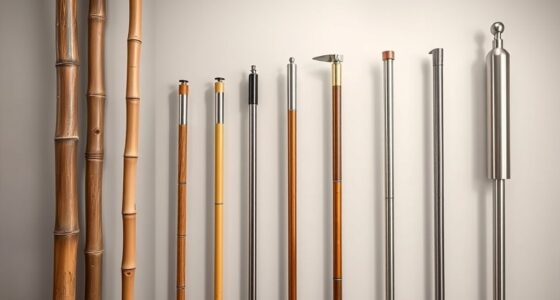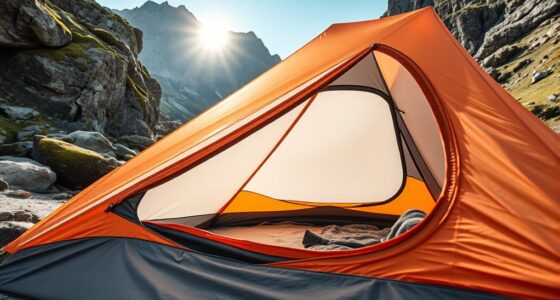When comparing tent shapes, physics shows that dome tents are easy to set up, stable, and shed wind efficiently thanks to their curved design. Tunnel tents need more effort but offer spaciousness and good force distribution when tensioned properly. Geodesic tents may be complex to assemble but excel in extreme weather, with multiple intersecting poles dispersing stress evenly. Continue exploring to see how each shape performs in different conditions and pick the best for your needs.
Key Takeaways
- Dome tents’ curved design evenly distributes stress, making them resistant to wind and easy to set up quickly.
- Tunnel tents rely on continuous poles for stability, but require tensioning to withstand strong winds effectively.
- Geodesic tents’ complex, intersecting pole structure offers superior strength and wind resistance, ideal for harsh weather conditions.
- The simplicity of dome tents facilitates rapid assembly, while geodesic tents demand more practice due to intricate setup.
- Material durability in all tent types depends on how well tension and stress are managed by their respective structures.

When choosing the perfect tent for your outdoor adventures, the shape can make all the difference. The design influences not just how easily you can set it up but also how well it withstands the elements. If you’re considering a dome, tunnel, or geodesic tent, understanding how their shapes impact material durability and ease of setup will help you pick the right one.
Dome tents are popular for their simple, curved structure. Their shape means fewer poles are needed, which makes setup quick and straightforward. You can usually pitch a dome tent alone in minutes, especially if it features color-coded pole sleeves or clips. The curved shape also contributes to material durability by evenly distributing tension across the fabric. This reduces stress points that can lead to tears or wear over time, making dome tents a reliable choice for frequent use. Their rounded design also sheds wind efficiently, helping them hold up against gusty conditions without requiring extra reinforcement.
Tunnel tents, with their elongated, cylindrical form, are known for offering spacious interiors and excellent stability in windy conditions. Setting up a tunnel tent involves connecting multiple poles in a sequence, which can take a bit more time, especially for beginners. However, once established, they’re quite sturdy and resist collapsing under pressure. The material durability of tunnel tents benefits from their shape because the continuous arc of the poles evenly distributes force, reducing stress on any single point. That said, their long, narrow profile can make them more susceptible to wind flapping if not properly guyed out, which can strain the fabric over time. Still, with proper tensioning, tunnel tents can last through many adventures.
Tunnel tents offer spacious interiors and stability but require proper tensioning for wind resistance.
Geodesic tents take the concept of shape even further, featuring multiple intersecting poles that form a complex, spherical structure. This design maximizes strength and stability, especially in severe weather. The multiple pole intersections distribute tension throughout the fabric evenly, which preserves material integrity over time. However, the intricate pole setup makes these tents more challenging to pitch, requiring some practice and patience. If you value durability and are prepared for a slightly more complex setup, a geodesic tent offers unmatched resilience and longevity. The shape’s physics ensures that wind, snow, or rain exert less destructive force on the fabric, making it ideal for extreme conditions.
Ultimately, your choice depends on your priorities. For quick setup and reliable material durability, a dome tent suits most casual campers. If you need space and stability in wind-prone areas, a tunnel tent might be better. For harsh environments demanding maximum strength, a geodesic tent’s intricate design and physics-backed durability make it the top option.
Frequently Asked Questions
How Does Wind Resistance Vary Among Different Tent Shapes?
You’ll notice wind resistance varies with tent shape because of how the wind flows around it. Dome tents, with their rounded surfaces, deflect wind efficiently, reducing resistance. Tunnel tents, with elongated sides, catch more wind, increasing strain. Geodesic tents are sturdy, with multiple intersecting poles that help distribute wind forces. Your choice of tent material and ventilation design also influences overall stability, making sure your tent holds up well in windy conditions.
Which Tent Shape Offers the Best Thermal Insulation?
Think of your tent as a cozy fortress, where shape efficiency guides thermal performance. Among shapes, domes often excel because their curved surfaces evenly distribute heat, reducing cold spots. This design traps warm air inside more effectively, making them ideal for insulation. So, if warmth matters most, a dome’s shape offers better thermal insulation, keeping you snug even in chilly weather.
Are Certain Shapes More Prone to Structural Failure?
You might notice that some tent shapes are more prone to structural failure, especially if you don’t consider tent material and seasonal durability. For example, tunnels can collapse under heavy snow, while geodesic designs distribute stress better, reducing failure risk. Your choice of material also impacts durability, making certain shapes more reliable in harsh weather. Always match your tent shape with your environment and guarantee quality materials for safety.
How Does Ease of Setup Differ for Dome, Tunnel, and Geodesic Tents?
When comparing ease of setup, dome tents are quick and simple, thanks to their fewer poles and lightweight design, making packing size smaller. Tunnel tents can be a bit more challenging because of multiple poles and larger tent weight, but they still set up fairly easily. Geodesic tents are more complex, with many intersecting poles, often requiring more time and effort, and they tend to be bulkier to pack.
What Are the Cost Differences Between These Tent Designs?
You’ll find that costs vary based on fabric durability and ventilation efficiency. Dome tents often cost more upfront due to durable materials and complex designs, while tunnel tents are generally cheaper but may need replacements sooner. Geodesic tents tend to be the most expensive because of their advanced engineering and high-quality fabrics. Consider how fabric durability affects longevity and ventilation efficiency influences comfort, helping you choose a design that balances cost with performance.
Conclusion
So, next time you’re choosing a tent, remember physics favors the dome for strength and stability, even if a tunnel feels easier to set up. Sure, geodesic designs look impressive, but their complexity isn’t always practical. Don’t let style overshadow function—think about how you’ll use your tent and the conditions you’ll face. With the right shape, you’ll stay comfortable and safe, no matter the weather. Trust physics to guide your perfect camping choice.










